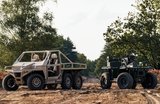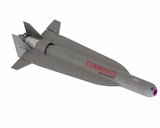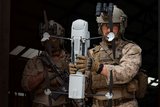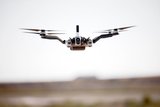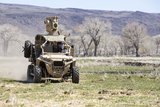Honeywell T-Hawk aids Fukushima Daiichi disaster recovery
Honeywell's T-Hawk Micro Air Vehicle (MAV) is helping emergency workers at Japan's Fukushima Daiichi nuclear facility get up-close video and photos inside the plant as they work to limit further radiation releases.
Three Honeywell employees, trained to fly the unmanned T-Hawks remotely, have flown five successful missions and captured hours of video and dozens of photos of the nuclear reactor. The four T-Hawks in service at Fukushima Daiichi have been adapted to carry radiation sensors.
"On behalf of all of us at Honeywell, our hearts go out to the people of Japan, particularly those who have suffered as a result of the earthquake and tsunami that damaged the Fukushima Daiichi nuclear plant and surrounding areas," said Tim Mahoney, president and chief executive officer of Honeywell Aerospace. "At Honeywell, we are proud of our commitment to safety and security, and we are grateful that our technologies can be deployed now to help the people of Japan in this historic time of need."
Currently deployed in war zones in Iraq and Afghanistan, the T-Hawk features unique hover-and-stare capability that enables pilots to hold it in one place and zoom in on features inside the damaged reactors while the T-Hawk sends live video and still images back to recovery workers. The T-Hawk also is capable of sending live in-flight video feeds to help workers focus on critical areas and adjust direction mid-flight. Pilots can control T-Hawk cameras to alter angles and get better views of damaged equipment. Just 14 inches in diameter, the T-Hawk can be flown into tight spaces where humans and other aircraft cannot go.
"The T-Hawk reminds us that innovative technologies initially created for defense purposes can find crucial roles in humanitarian and disaster recovery efforts," Mahoney said.
Weighing just 17 pounds, the T-Hawk is a ducted-fan vertical takeoff and landing air vehicle originally designed in conjunction with a Defense Advanced Research Projects Agency (DARPA) Advanced Concept Technology Demonstration (ACTD) program. Pilots can determine manual or autonomous flight paths from up to six miles away for up to 40 minutes at a time.
The T-Hawk is a proven force multiplier in Afghanistan and Iraq, where systems have been averaging more than six hours of flight time a day. The T-Hawk is used in Afghanistan for route clearance, infantry assault, and explosive ordnance disposal missions, where, together with its similar work in Iraq, it has cumulatively flown more than 17,000 hours. The United Kingdom's Ministry of Defence also deploys the T-Hawk for combat missions in Afghanistan and trains with the T-Hawk in Afghanistan and Jordan. The T-Hawk is currently being tested for urban use by the Miami-Dade Police Department.
Source: Honeywell
More from Uncrewed Vehicles
-
![Cummings Aerospace showcases Hellhound loitering munition designed for US Army’s LASSO programme (video)]()
Cummings Aerospace showcases Hellhound loitering munition designed for US Army’s LASSO programme (video)
Cummings Aerospace presented its turbojet-powered Hellhound loitering munition at SOF Week 2025, offering a man-portable solution aligned with the US Army’s LASSO requirements.
-
![SOF Week 2025: PDW unveils attritable FPV drone for SOF operations at scale]()
SOF Week 2025: PDW unveils attritable FPV drone for SOF operations at scale
PDW has revealed its Attritable Multirotor First Person View drone at SOF Week 2025, offering special operations forces a low-cost, rapidly deployable platform for strike and ISR missions, inspired by battlefield lessons from Ukraine.
-
![SOF Week 2025: Teledyne FLIR white paper provides guidance on reusable loitering munitions]()
SOF Week 2025: Teledyne FLIR white paper provides guidance on reusable loitering munitions
Teledyne FLIR is highlighting the emerging requirements for 'recoverable and re-usable' loitering munitions across the contemporary operating environment during this week’s SOF Week conference in Tampa, Florida.
-
![SOF Week 2025: Kraken Technology group debuts K3 Scout USV in North America]()
SOF Week 2025: Kraken Technology group debuts K3 Scout USV in North America
High-performance maritime industry player Kraken Technology Group, based in the UK, has used the SOF Week conference in Tampa, Florida this week to debut its K3 Scout uncrewed surface vessel (USV) to the North American market.
-
![Palladyne AI and Red Cat to demonstrate capabilities for autonomous drone swarms to the US military]()
Palladyne AI and Red Cat to demonstrate capabilities for autonomous drone swarms to the US military
Red Cat and Palladyne AI recently conducted a cross-platform collaborative flight involving three diverse heterogeneous drones.
-
Jammer resistant drone designs spark search for countermeasures
The Russia-Ukraine conflict has driven another stage of evolution for drones and the counter measures to defend against them.








